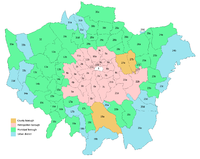- Metropolitan Borough of Bermondsey
-
Bermondsey Motto: Prosunt gentibus artes (Arts profit the people) 
Bermondsey within the County of LondonGeography Status Metropolitan borough 1911 area 1,500 acres (6.1 km2) 1931 area 1,503 acres (6.08 km2) 1961 area 1,504 acres (6.09 km2) HQ Spa Road History Origin Bermondsey parish
Rotherhithe parish
St Olave DistrictCreated 1900 Abolished 1965 Succeeded by London Borough of Southwark Demography 1911 population
- 1911 density125,903
84/acre1931 population
- 1931 density111,542
74/acre1961 population
- 1961 density51,860
34/acrePolitics Governance Bermondsey Borough Council 
Coat of arms of the borough councilThe Metropolitan Borough of Bermondsey was a Metropolitan borough in the County of London, created in 1900 by the London Government Act 1899. It was abolished and its area became part of the London Borough of Southwark in 1965.
Contents
History
The borough replaced the parish vestries of Bermondsey and Rotherhithe, and the St Olave District Board of Works (consisting of the two parishes of St John Horsleydown and Southwark St Olave and St Thomas)[1]
The town hall was on Spa Road, SE16, and was bombed during World War 2. After the war a neighbouring building was used and this is now used as offices for Southwark Council. The population declined sharply after the Second World War, being cut by about half from 1931 to 1951.
Coat of arms
The borough was granted a coat of arms in 1901.[2] The design included references to the three constituent authorities. The lion, crozier and two letters B represent Bermondsey vestry, and are derived from the insignia of Bermondsey Abbey. The crown and axe were the emblem of St Olave's District Board of Works, and were derived from the royal arms of Norway, Saint Olave being the anglicised name of King Olaf II of Norway. The ship represented Rotherhithe and the Surrey Commercial Docks.
The Latin motto adopted by the borough was Prosunt gentibus artes or "Arts profit the people", and was adapted from Ovid's Metamorpheses.
Statistics
The area of the Borough was 1,504 acres (6.1 km2). The population from the Census returns was:
St Olave's District Board of Works and Civil Parishes 1801-1899
Year[3] 1801 1811 1821 1831 1841 1851 1861 1871 1881 1891 Population 46,281 49,397 57,148 62,637 68,701 85,308 101,913 122,398 134,632 136,660 Metropolitan Borough 1900-1961
Year[4] 1901 1911 1921 1931 1941 1951 1961 Population 130,760 125,903 119,452 111,542 [5] 60,638 51,860 Politics
In the first election to the borough council, held on 1 November 1900 the Moderates (supported by the Conservative party) gained a majority. The opposition group was formed by the Progressive Party. The Moderates retained their majority at the 1903 elections. In 1906 the Moderate group was renamed Municipal Reform. In 1909 The Progressives won 27 seats and the Independent Labour Party 1 to the Municipal Reform's 26 seats, but the latter party retained power through the aldermanic elections. They regained an overall majority of councillors at the 1912 elections.
Local elections were postponed during the First World War, with the next poll held in 1919. The results were a major reverse for the Municipal Reform party with just two councillors elected. The Progressives formed the largest party with 27 seats, followed by the Labour Party with 24. There was one independent councillor. At the 1922 elections Labour gained a majority with 38 seats. The opposition was formed by a Ratepayers Association with 14 councillors. Labour held the council at the subsequent elections, holding all the seats from 1934 to 1945 and from 1949 until the borough's abolition.[6]
References
- ^ F A Youngs, Guide to the local administrative units of England, Volume I, 1979
- ^ Letters Patent dated March 25, 1901
- ^ Statistical Abstract for London, 1901 (Vol. IV).
- ^ Bermondsey MetB: Census Tables accessed 14 June 2007
- ^ The census was suspended for World War II
- ^ Election results as reported in The Times, 3 November, 1900; 4 November 1903; November 3, 1906; November 2, 1909; November 2, 1912; November 4, 1919; November 4, 1925; November 3, 1928; November 4, 1931; November 3, 1934; November 3, 1937; November 2, 1945; May 7, 1949; May 7, 1953; May 11, 1956; May 8, 1959; May 12, 1962
External links
Local government districts abolished or transferred by the London Government Act 1963 London · CC Battersea · Bermondsey · Bethnal Green · Camberwell · Chelsea · Deptford · Finsbury · Fulham · Greenwich · Hackney · Hammersmith · Hampstead · Holborn · Islington · Kensington · Lambeth · Lewisham · Paddington · Poplar · Shoreditch · Southwark · St. Marylebone · St. Pancras · Stepney · Stoke Newington · Wandsworth · Westminster · Woolwich
Constituent parts of Greater LondonEssex Barking · Chigwell (part) · Chingford · Dagenham · East Ham · Hornchurch · Ilford · Leyton · Romford · Walthamstow · Wanstead and Woodford · West Ham
Hertfordshire Middlesex · CC Acton · Brentford and Chiswick · Ealing · Edmonton · Enfield · Feltham · Finchley · Friern Barnet · Harrow · Hayes and Harlington · Hendon · Heston and Isleworth · Hornsey · Ruislip-Northwood · Southall · Southgate · Tottenham · Twickenham · Uxbridge · Wembley · Willesden · Wood Green · Yiewsley and West Drayton
Kent Surrey Transfers Categories:- Metropolitan boroughs of the County of London
- History of Southwark
- 1900 establishments in the United Kingdom
- 1965 disestablishments
Wikimedia Foundation. 2010.


